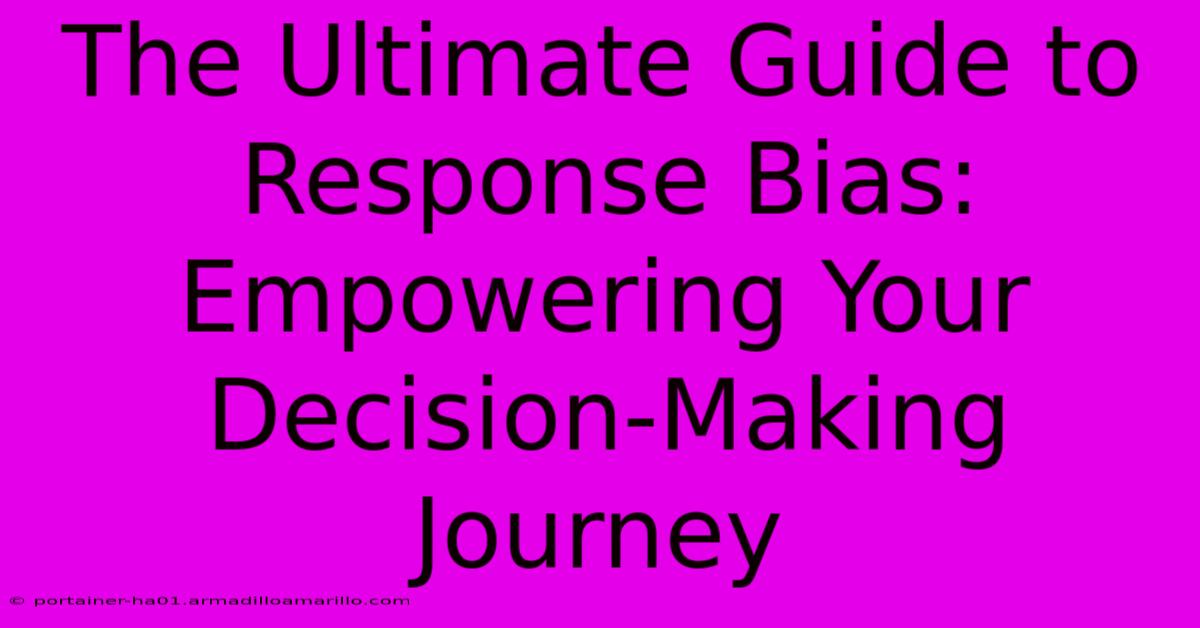The Ultimate Guide To Response Bias: Empowering Your Decision-Making Journey

Table of Contents
The Ultimate Guide to Response Bias: Empowering Your Decision-Making Journey
Response bias. It's a subtle yet powerful force that can silently distort our perceptions and lead to flawed decisions. Understanding and mitigating response bias is crucial for anyone aiming for clear, objective thinking, whether in personal life, business, or research. This ultimate guide delves deep into the world of response bias, equipping you with the knowledge and strategies to navigate its complexities and make more informed choices.
What is Response Bias?
Response bias, in its simplest form, refers to systematic errors in responding to surveys or other assessments. These errors aren't random; they arise from the way questions are framed, the context in which they're asked, or the inherent tendencies of the respondent. It represents a deviation from truthfulness or accuracy, clouding the actual data and potentially skewing results significantly. This can lead to inaccurate conclusions and ineffective decision-making. Think of it as a sneaky intruder in your data collection process, whispering misleading information into your ears.
Types of Response Bias: A Closer Look
Several types of response bias exist, each with its unique characteristics and potential impact:
-
Acquiescence Bias (Yea-Saying): This is the tendency to agree with statements regardless of their content. Respondents might simply agree to avoid conflict or appear agreeable, even if they don't truly agree with the statement.
-
Social Desirability Bias: This involves answering questions in a way that presents oneself in a favorable light, even if it's not entirely truthful. People might underreport undesirable behaviors or overreport desirable ones.
-
Confirmation Bias: This pervasive bias involves seeking out and interpreting information that confirms pre-existing beliefs, while ignoring contradictory evidence. It's a significant hurdle to objective decision-making.
-
Recall Bias: This bias occurs when individuals struggle to accurately recall past events or experiences. Memory is fallible, and this can lead to inaccurate reporting in surveys or interviews.
-
Non-response Bias: This arises when a significant portion of the intended respondents don't participate in a survey or study. The non-respondents might differ systematically from the respondents, leading to biased results.
-
Question Order Bias: The order in which questions are asked can influence responses. Earlier questions can prime respondents to answer subsequent questions in a particular way.
Identifying and Mitigating Response Bias
Recognizing response bias is the first step towards neutralizing its impact. Here are several strategies to minimize its influence:
1. Careful Questionnaire Design:
- Neutral Wording: Avoid leading questions or those that suggest a preferred answer. Use neutral and unbiased language.
- Balanced Scales: Employ scales that allow for both positive and negative responses.
- Randomized Question Order: Shuffle the order of questions to reduce the effect of question order bias.
- Pilot Testing: Conduct a pilot study with a small group before deploying the survey to identify potential problems.
2. Ensuring Anonymity and Confidentiality:
Creating a safe and anonymous environment encourages honest responses, minimizing social desirability bias.
3. Employing Multiple Methods:
Using various data collection methods (e.g., surveys, interviews, observations) can help cross-validate findings and identify potential biases.
4. Statistical Techniques:
Various statistical techniques can help to identify and adjust for certain types of response bias. Consult with a statistician for guidance.
5. Awareness and Training:
Educating researchers and interviewers about various response biases can improve data quality.
The Impact of Response Bias on Decision-Making
The consequences of ignoring response bias can be severe, leading to:
- Inaccurate Research Findings: Studies affected by response bias produce misleading conclusions, undermining the validity of research.
- Poor Business Decisions: Marketing campaigns, product development, and other strategic decisions can be flawed if based on biased data.
- Ineffective Policy Making: Government policies and social programs can be ineffective if they rely on inaccurate data.
Conclusion: Embracing Objectivity
Understanding response bias is a crucial skill for anyone involved in data collection, analysis, or decision-making. By employing the strategies outlined in this guide, you can significantly reduce the influence of response bias and pave the way for more objective, informed, and ultimately, better decisions. The journey to empower your decision-making begins with recognizing and addressing these subtle yet powerful biases. Embrace objectivity, and watch your decisions transform.

Thank you for visiting our website wich cover about The Ultimate Guide To Response Bias: Empowering Your Decision-Making Journey. We hope the information provided has been useful to you. Feel free to contact us if you have any questions or need further assistance. See you next time and dont miss to bookmark.
Featured Posts
-
Unleash Your Passion For Humanity Discover Job Opportunities That Ignite Change
Feb 07, 2025
-
Explore The Nexus Of History And Culture The Black American Flag With Red Stripe As A Time Capsule
Feb 07, 2025
-
Turn Your Kitchen Into A Vintage Oasis Big Chill Appliances As Your Guide
Feb 07, 2025
-
Beyond The Picture The Story Behind Black And White Photo Spot Lighting
Feb 07, 2025
-
Out Of Office And Out Of Line Hilarious Sign Offs For Your Vacation Replies
Feb 07, 2025
